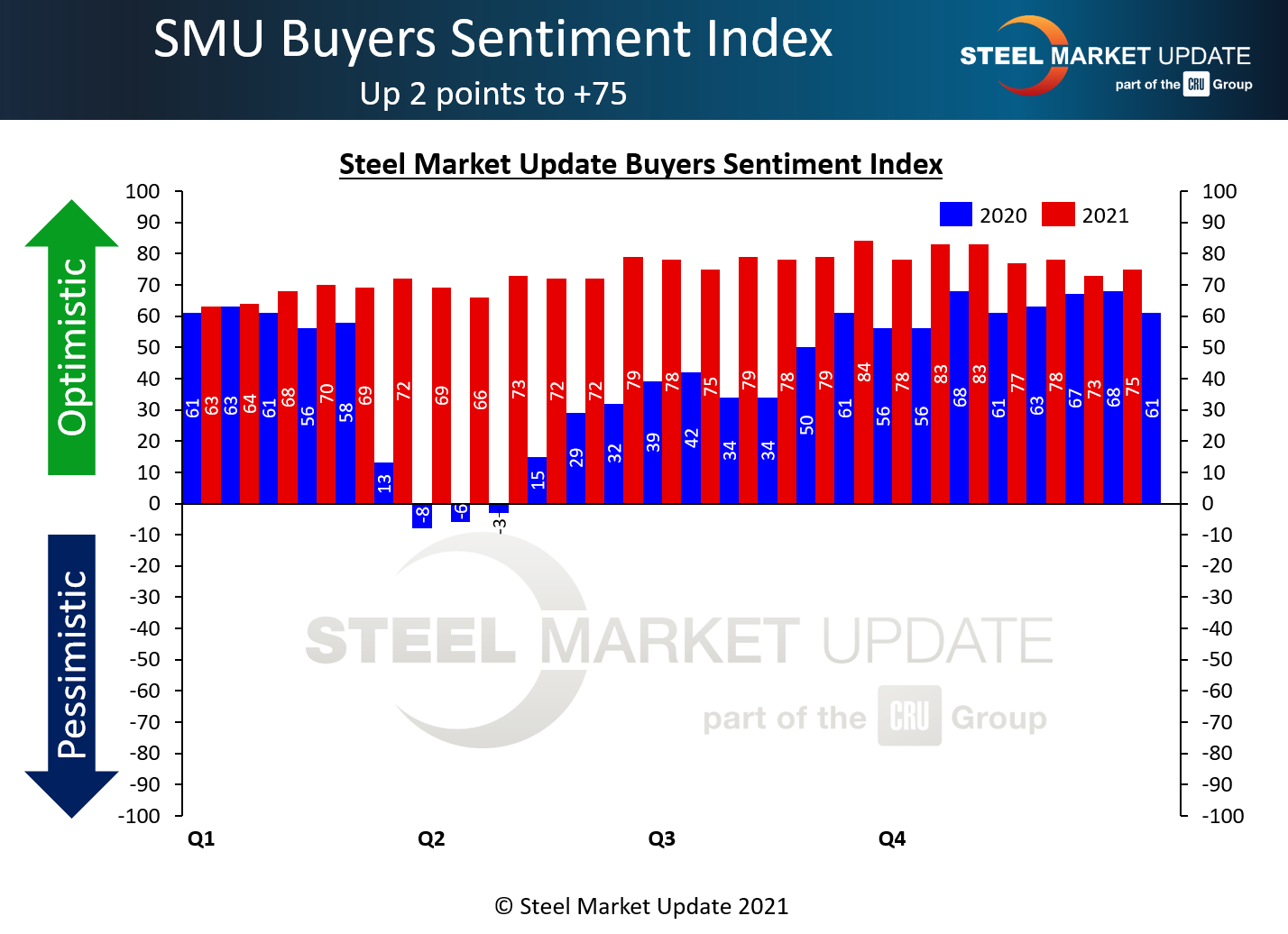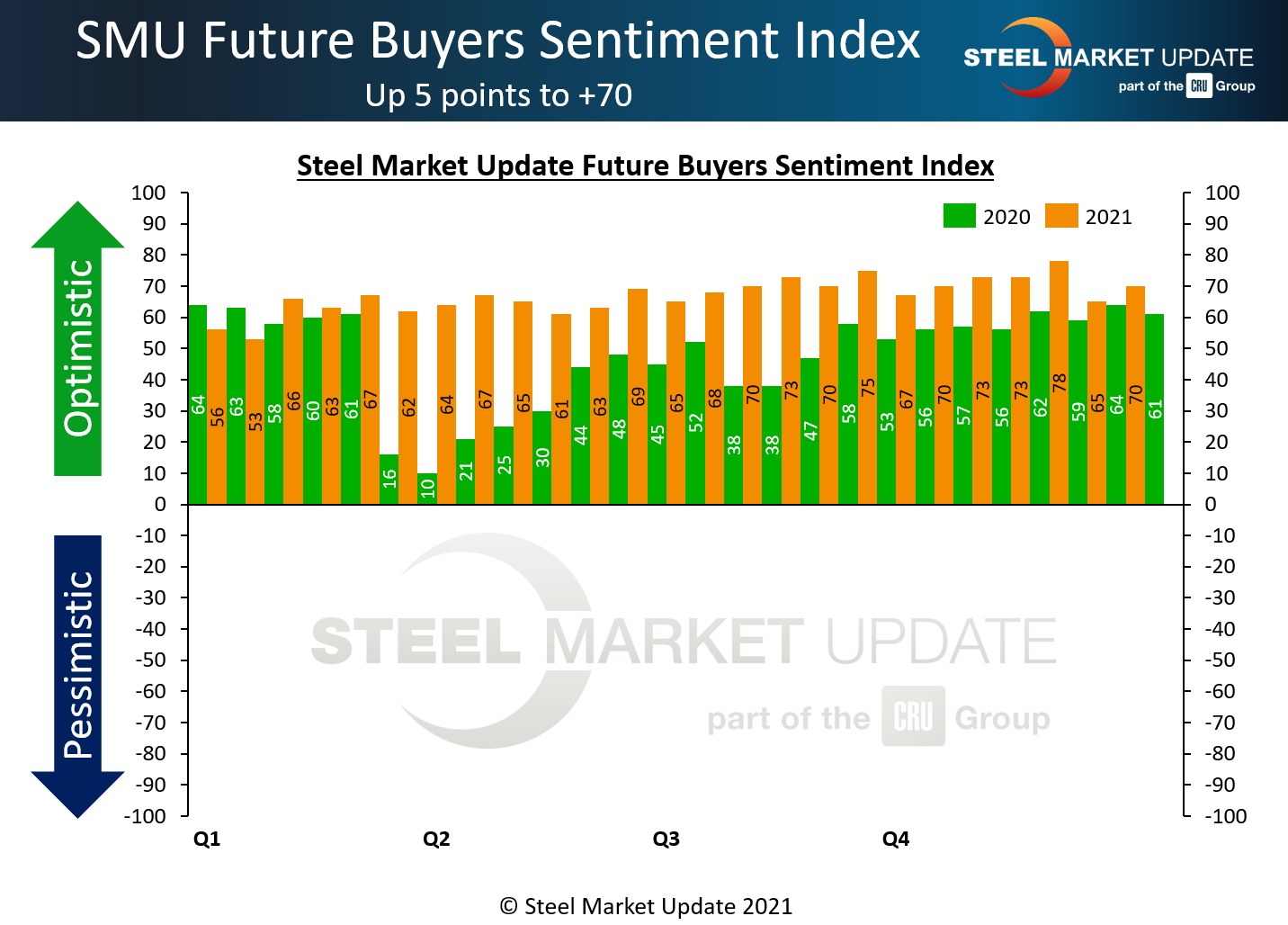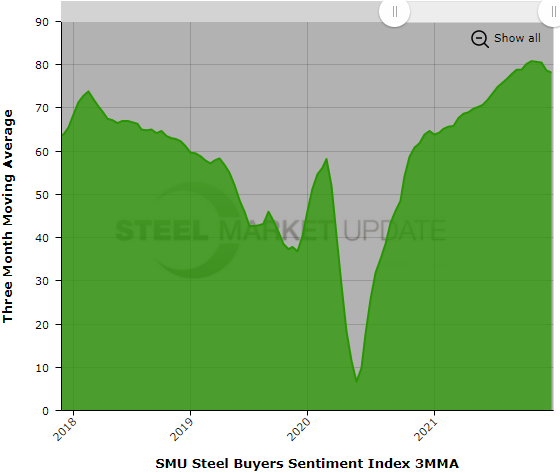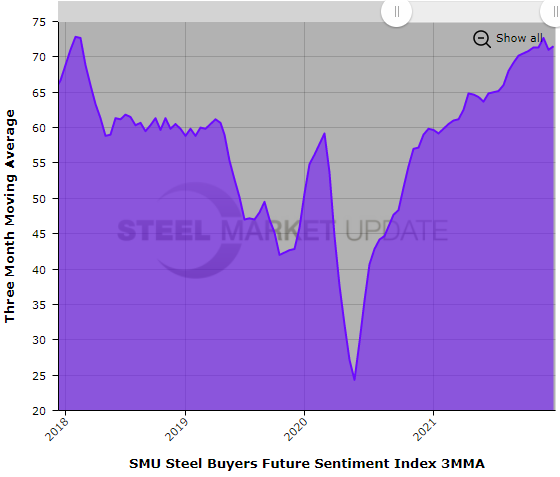SMU Data and Models

SMU Steel Buyers Sentiment: Optimism Unchecked by Price Decline
Written by Tim Triplett
December 10, 2021
With 2022 just around the corner, steel buyers are looking back at one of the most profitable years in their history – thanks to all-time-high steel prices seen in 2021. That explains some of the staying power of lofty readings in Steel Market Update’s Sentiment Index.
SMU surveys buyers every two weeks and asks how they view their chances of success in the near and longer term. SMU’s Current Buyers Sentiment Index registered +75, up two points over the past two weeks, and just nine points away from the all-time high of +84 in early September.
Future Sentiment – which measures steel buyers’ feelings about their prospects three to six months in the future – increased by five points to +70, just seven points below the record reading of +77 in February 2018.


Measured as a three-month moving average (3MMA) to smooth out the variability, the Current Sentiment 3MMA stood at +78.17 this week, while the Future Sentiment 3MMA was at +71.50, on the 100-point scale.


Steel buyers’ sentiment may be a leading indicator when prices are on the way up, but it can be a trailing indicator on the way down. Steel prices have declined by more than 10% and are widely forecast to continue eroding well into next year. Yet so far buyers’ optimism and bullishness on the future remain undampened. Industry sentiment can be expected to follow steel prices downward. You could say it’s surprising that hasn’t happened already. But it’s also possible that lower prices and stable demand might mean better times ahead for manufacturers who won’t face the same cost pressures they did over the last 12 months.
What Respondents Had to Say
“November was the best month in our 60-year history. Stop me if you’ve heard me say that before.”
“2022 ought to be our second-best year in company history, trailing only the profits of ’21.”
“Demand should improve as prices moderate; building products slowed down due to the high prices.”
“Intangibles have become the new market fundamentals. Until they either stop being intangible or start becoming more predictable, then no one can be certain of success when market manipulation is at work.”
“I fear trade laws will become more protective and really hurt our main import sources and make products less competitive.”
“There’s too much uncertainty and too many unknowns on the future.”
About the SMU Steel Buyers Sentiment Index
SMU Steel Buyers Sentiment Index is a measurement of the current attitude of buyers and sellers of flat-rolled steel products in North America regarding how they feel about their company’s opportunity for success in today’s market. It is a proprietary product developed by Steel Market Update for the North American steel industry.
Positive readings run from +10 to +100. A positive reading means the meter on the right-hand side of our home page will fall in the green area indicating optimistic sentiment. Negative readings run from -10 to -100. They result in the meter on our homepage trending into the red, indicating pessimistic sentiment. A reading of “0” (+/- 10) indicates a neutral sentiment (or slightly optimistic or pessimistic), which is most likely an indicator of a shift occurring in the marketplace. Sentiment is measured via Steel Market Update surveys that are conducted twice per month. We display the meter on our home page.
We send invitations to participate in our survey to more than 600 North American companies. Our normal response rate is 100-150 companies. Approximately 40 percent are manufacturers, 45 percent are service centers/distributors, and 15 percent are steel mills, trading companies or toll processors involved in the steel business.
Click here to view an interactive graphic of the SMU Steel Buyers Sentiment Index or the SMU Future Steel Buyers Sentiment Index.
By Tim Triplett, Tim@SteelMarketUpdate.com

Tim Triplett
Read more from Tim TriplettLatest in SMU Data and Models

SMU Survey: Buyers’ Sentiment rebounds from multi-year low
Both of SMU’s Steel Buyers’ Sentiment Indices edged higher this week. Current Sentiment rebounded from a near five-year low, while Future Sentiment rose to a two-month high

SMU flat-rolled market survey results now available
SMU’s latest steel buyers market survey results are now available on our website to all premium members.

SMU Survey: Sheet lead times pull back after early-June blip, plate holds
Following the uptick seen two weeks ago, lead times eased this week for all four sheet products tracked by SMU, while plate lead times held steady, according to this week’s market survey.

SMU Survey: Pricing power abruptly shifts to steel buyers
The majority of steel buyers responding to our latest market survey say domestic mills are more willing to talk price on sheet and plate products than they were earlier this month. Sheet negotiation rates rebounded across the board compared to early June, while our plate negotiation rate hit a full 100%.

Service centers: Mill orders down marginally in May
SMU’s Mill Order Index (MOI) declined for a third straight month in May, but only marginally.
